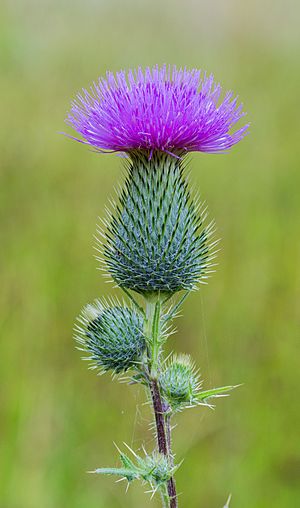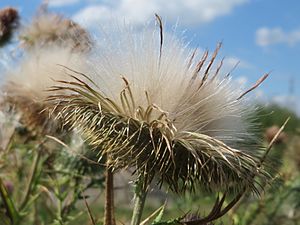Spear thistle facts for kids
Quick facts for kids Spear thistle |
|
|---|---|
 |
|
| Plant in flower, Joure, Netherlands | |
 |
|
| Seedhead | |
| Scientific classification | |
| Genus: |
Cirsium
|
| Species: |
vulgare
|
| Synonyms | |
|
Synonymy
Ascalea lanceata Hill
Ascalea lanceolata (L.) Hill Carduus divaricatus Gllib. Carduus firmus Steud. Carduus lanceolatus L. Carduus vulgaris Savi Chamaepeuce firma DC. Cirsium abyssinicum Sch.Bip. ex A.Rich. Cirsium auriculatum Camus ex Beleze Cirsium balearicum Willk. Cirsium britannicum Scop. Cirsium dubium Lojac. Cirsium firmum (C.Presl) Arcang. Cirsium fraternum DC. Cirsium lanceolatum (L.) Scop. Cirsium lanigerum Nägeli Cirsium leucanicum Lojac. Cirsium linkii Nyman Cirsium longespinosum Tod. ex Nyman Cirsium microcephalum Lange Cirsium mielichhoferi Saut. Cirsium misilmerense Ces., Pass. & Gibelli Cirsium nemorale Rchb. Cirsium spurium Delastre Cirsium strigosum (Hoffmanns. & Link) Cout. Cnicus firmus J.Presl & C.Presl Cnicus lanceolatus (L.) Willd. Cnicus misilmerensis Tineo ex Ces., Pass. & Gibelli Cnicus strigosus Hoffmanns. & Link Cynara lanceata Stokes Eriolepis lanceolata (L.) Cass. Lophiolepis dubia Cass. Cirsium atticum Sch.Bip. ex Nyman Cirsium balearicum (Willk.) Porta Cirsium crinitum Boiss. ex DC. Carduus nemoralis E.H.L.Krause Cirsium silvaticum Tausch |
|
The spear thistle (scientific name: Cirsium vulgare) is a common plant. It is also known as the bull thistle or common thistle. This plant is part of the Asteraceae family, which includes many types of daisies and sunflowers.
Spear thistles originally grew across most of Europe, Western Asia, and North Africa. However, they have now spread and grown naturally in other places like North America and Australia. In some areas, they are considered an invasive weed. The spear thistle is also the national flower of Scotland.
This plant is very important for pollinators because it produces a lot of nectar. Nectar is a sweet liquid that insects like bees and butterflies drink. In a study in the UK, the spear thistle was ranked among the top plants for nectar production. This shows how helpful it is to insects that help plants grow.
Contents
What Does the Spear Thistle Look Like?
The spear thistle is usually a biennial plant. This means it lives for two years. In its first year, it grows a flat cluster of leaves close to the ground, called a rosette. It also grows a long main root, called a taproot, which can be up to 70 centimeters (about 27 inches) long.
Growth and Features
In its second year, the spear thistle grows a tall flowering stem. This stem can reach 1 to 1.5 meters (about 3 to 5 feet) tall, and sometimes even up to 1.8 meters (about 6 feet). The stem has many spiny ridges along its length.
The leaves are spiky and grayish-green. They are deeply cut into spear-shaped sections, which is how the plant got its English name. The largest leaves are at the bottom of the plant, and they can be up to 30 centimeters (about 12 inches) long. Smaller leaves grow higher up on the stem.
Flowers and Seeds
The flowers of the spear thistle are pink-purple and look like small brushes. Each flower head is about 2.5 to 5 centimeters (1 to 2 inches) wide. All the tiny flowers inside the head look similar.
After the flowers bloom, they produce seeds. These seeds are about 5 millimeters long. Each seed has a fluffy, feathery top called a pappus. This pappus helps the seeds float on the wind, allowing them to spread to new places.
Spear Thistle in Nature
Spear thistles often grow in places where the ground has been disturbed, like empty lots or fields. They can also grow well in areas where animals graze. Most grazing animals do not like to eat the spiky thistle, so it can survive easily. Soils rich in nitrogen help the plant grow even more.
Helping Pollinators and Birds
The flowers are a great source of nectar for many insects. These include honey bees, wool-carder bees, and many different butterflies. This makes the spear thistle an important plant for supporting local wildlife.
The seeds of the spear thistle are also a food source. Birds like goldfinches, linnets, and greenfinches enjoy eating them. The seeds are spread by wind, water, and sometimes by ants. They usually sprout soon after they are spread.
Weed or Helpful Plant?
In some places, like the UK and parts of Australia and the US, the spear thistle is called an "injurious weed." This means it can cause problems for farming or other land uses. Unlike some other thistles, the spear thistle only spreads by its seeds, not by pieces of its roots. Farmers can control it by digging up the roots before the seeds form.
However, the spear thistle also has many good qualities. Besides providing nectar, its seeds are a food source for birds like the American goldfinch. These birds also use the fluffy down from the seed pods to build their nests. The plant is also a host plant for the Painted lady butterfly, meaning the butterfly larvae (caterpillars) eat its leaves. Large butterflies like the monarch butterfly can easily feed from its big flowers.
Some farmers choose to let spear thistles grow in certain areas, like beetle banks. This is because the plant helps support pollinators and birds that eat pests. For them, the benefits of the thistle can be greater than its drawbacks. When it doesn't grow too thickly, it can also be a nice part of a meadow landscape.
Other Names for the Spear Thistle
The spear thistle has a few other common names. People sometimes call it the bull thistle. It is also known as the Scots thistle, Scottish thistle, or Scotch thistle because it is the national flower of Scotland. Another simple name for it is the common thistle.
Uses of the Spear Thistle
Even though it's spiky, parts of the spear thistle can be used!
- Stems: The outer spiny layer of the stems can be peeled off. The inside part can then be steamed or boiled and eaten.
- Roots: The long taproots of young thistles (before they flower) can be eaten. They can be eaten raw or cooked.
- Flowers: In some parts of rural Italy, the dried flowers are soaked in water. This liquid is then used to help curdle goat's milk, which is the first step in making cheese.
Spear Thistle in Culture
The spear thistle is an important symbol in Scotland. It is featured in some Scottish ceremonies, such as the "Riding of the Marches" event held every July in Langholm. In 1992, a spear thistle used in this event measured six feet long!
The spear thistle is also the official emblem of Newton Regis, a village in England.
See also
 In Spanish: Cirsium vulgare para niños
In Spanish: Cirsium vulgare para niños

